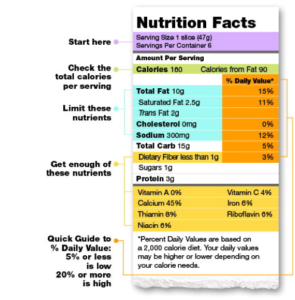Portion Distortion

Over the past few decades, portion sizes have significantly increased. Since the 1970’s, the size of our average foods have grown up to 138%. The surface area of an average dinner plate has increased 36% since the 1960’s. Today the common dinner plate measures 11 to 12 inches across while a few decades ago they measured 7 to 9 inches. Meals in restaurants can be large enough to feed two people, sometimes even large enough to feed three! These portion increases aren’t just found in restaurants but at the grocery store and vending machines as well.
| 20 Years Ago | Today |
| 3 inch bagel (140 calories) | 6 inch bagel (350 calories) |
| 1 cup of spaghetti with sauce & 3 small meatballs (500 calories) | 2 cups of pasta with sauce & 3 large meatballs (1025 calories) |
| 2.4 ounces of French fries (210 calories) | 6.9 ounces of French fries (610 calories) |
| 6.5 ounce pop (85 calories) | 20 ounce pop (250 calories) |
| 1.5 ounce muffin (210 calories) | 4 ounce muffin (500 calories) |
 How are serving sizes different from portion sizes? Serving sizes are a standard unit of measuring foods and are set by dietary guidelines by Health Canada. Portions are the size or amount offered in packaged foods, in a restaurant or the amount a person chooses to put on their plate. Many times, a single portion can have more than one serving.
How are serving sizes different from portion sizes? Serving sizes are a standard unit of measuring foods and are set by dietary guidelines by Health Canada. Portions are the size or amount offered in packaged foods, in a restaurant or the amount a person chooses to put on their plate. Many times, a single portion can have more than one serving.
To give an example, half of a bagel is one serving of grain products but most often the whole bagel is consumed. A 20 ounce pop which is usually consumed as a single portion contains 2.5 servings. The best way to make sure of serving sizes is to read the Nutrition facts label provided on the package.
Tips for maintaining regular portion sizes:
- Split a large salad or main dish with a friend.
- Take home half of a restaurant meal.
- Share that tub of popcorn with a friend.
- Be mindful or how much is being eaten. Put a reasonable amount of food in a bowl or container when eating in front of the TV.
- Eat from smaller plates and bowls.
- When eating meals at home, keep excess food out of reach to minimize the temptation of second and third helpings.
- Control hunger between meals by snacking on fruits and vegetables.
Tips for reading The Nutrition Facts Label:
- Compare the serving size that the Nutrition Facts Label provides to the whole amount of food in the package.
- Check total calories per serving.
- Try to choose foods with 5% Daily Value or less of Saturated fats, Trans fats, Cholesterol and Sodium.
- Try to choose foods with 20% Daily Value or more of Potassium, Fibre, Vitamins A and C, Calcium and Iron.



Comments are closed.